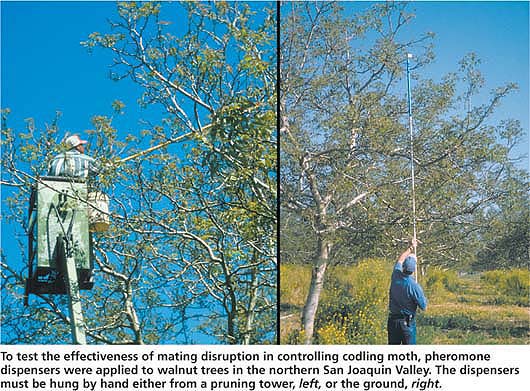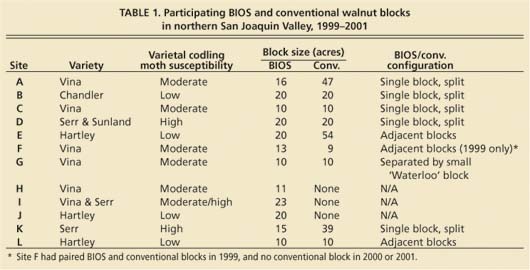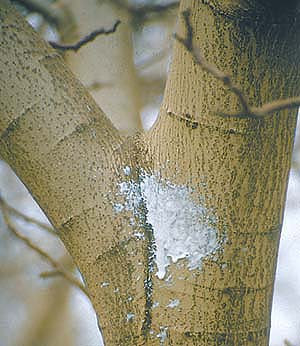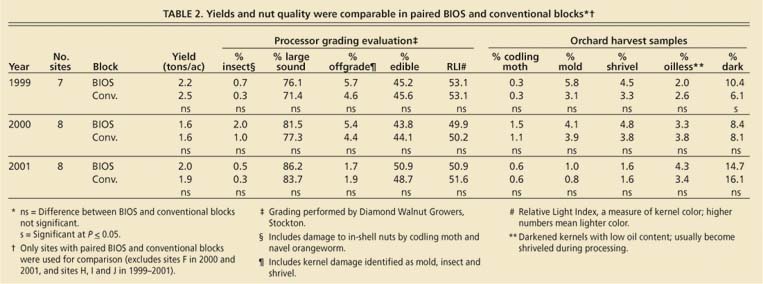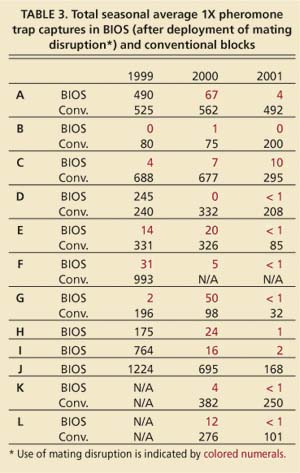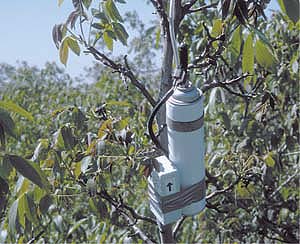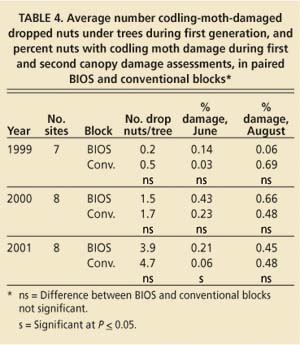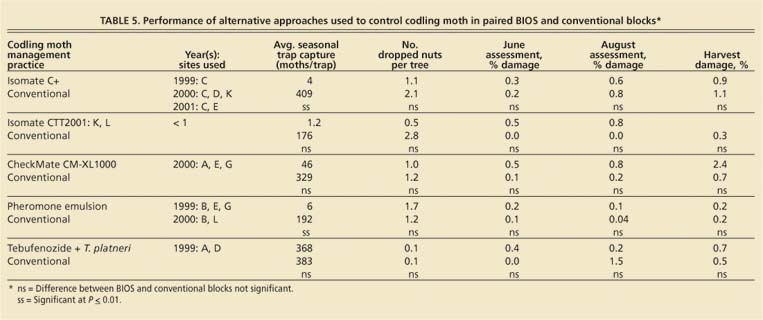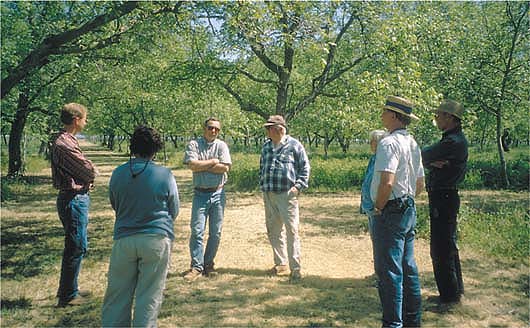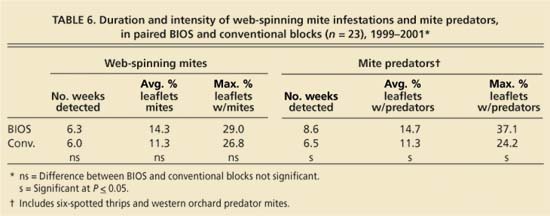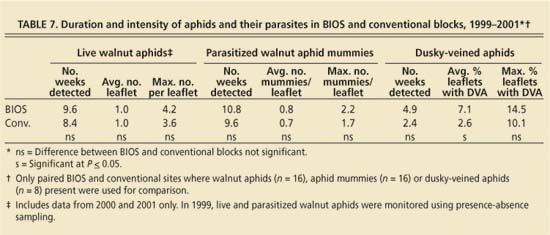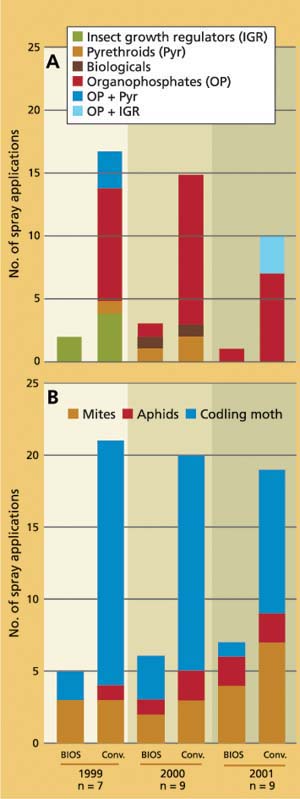All Issues
BIOS approach tested for controlling walnut pests in San Joaquin Valley
Publication Information
California Agriculture 57(3):86-92. https://doi.org/10.3733/ca.v057n03p86
Published July 01, 2003
PDF | Citation | Permissions
Abstract
As concerns increase over changes in pesticide regulations, farmworker safety, surface and groundwater contamination and escalating costs and uncertainties associated with chemical controls, walnut growers need effective and cost-efficient ways to produce walnuts with minimal use of pesticides. This study compared the effectiveness of Biologically Integrated Orchard Systems (BIOS) with conventionally managed walnut orchards in the northern San Joaquin Valley from 1999 to 2001. We found no significant differences between BIOS and conventional blocks in nut quality or yields. Codling moth was effectively controlled by pheromone disruption and alternative pest-control methods. Mating disruption, by itself, appears to provide good control of codling moth in many orchards. However, it is still more expensive for growers than conventional pest-control methods.
Full text
The Community Alliance with Family Farmers (CAFF), through its innovative Biologically Integrated Orchard Systems (BIOS) project in Yolo and Solano counties, demonstrated from 1996 to 1999 that it is possible to reduce pesticide use and still produce good yields of high-quality walnuts with low levels of pest damage (CAFF 1999). BIOS emphasizes intensive monitoring, biological control and beneficial insect habitat enhancement to control pests; cover crops, animal manures and composts to build soil; and measured use of fertilizers based on nutrient budgeting and leaf tissue analysis to optimize fertilizer use (Swezey and Broome 2000).
To test the effectiveness of mating disruption in controlling codling moth, pheromone dispensers were applied to walnut trees in the northern San Joaquin Valley. The dispensers must be hung by hand either from a pruning tower, left, or the ground, right.
From 1999 to 2001, we conducted a project aimed at adapting the BIOS model to fit the biological, economic and infrastructure conditions of the walnut farming industry in the northern San Joaquin Valley. Our primary focus was pest management, including control of three key walnut pests: codling moth, aphids and mites.
BIOS, conventional blocks compared
Ten growers participated in the project in 1999, and 12 in 2000 and 2001. Each grower designated a block of mature walnuts for BIOS implementation. BIOS blocks were chosen based on variety, previous crop and pest history and the growers' preferences. These blocks included a variety of walnut cultivars and orchard designs in eastern San Joaquin and northern Stanislaus counties (table 1). Nine of the 12 growers in 2000 and 2001 designated an adjacent portion of the same block or a nearby block – of the same variety and similar size, age and cultural characteristics – to serve as a conventionally managed comparison block. At our request, most of the growers retained a pest control advisor (PCA) experienced in BIOS or other alternative farming methods to provide management advice in BIOS blocks. Independent consultants or PCAs from agricultural supply dealers provided consulting in conventional blocks.
A customized plan for managing codling moth and other pests was developed for each BIOS block by a team of technical experts, consisting of the local UC Cooperative Extension farm advisor, two UC integrated pest management advisors, two walnut growers with BIOS or organic walnut farming experience, four individuals with BIOS-related expertise (cover crops, soil building, pest management), two PCAs and a representative of a major California walnut processor. Growers agreed to follow the management plan as closely as possible in BIOS blocks. Growers and their consultants and PCAs determined pest management practices in the conventionally managed comparison blocks.
TABLE 1. Participating BIOS and conventional walnut blocks in northern San Joaquin Valley, 1999–2001
We developed a comprehensive monitoring program, which included weekly monitoring of BIOS and conventionally managed blocks by a project field scout from April through October for key pests, using established sampling methods (UC IPM 1987, 2000). Monitoring results were summarized and delivered to growers and their PCAs each week.
We used data from growers' harvest delivery and grading reports to compare yield and quality in BIOS and conventionally managed blocks. We also evaluated nut quality using harvest samples we collected when trees were shaken for commercial harvest. We inspected 60 randomly selected nuts collected from each of 10 preselected trees per block for quality defects and pest damage (total of 600 nuts per block). These trees were located at regular intervals along a middle row in each block. We also obtained yield information from questionnaires completed by growers each year.
Managing codling moth
Codling moth is the key insect pest of walnuts, and it was the major focus of our efforts. Codling moth has three generations per year in the northern San Joaquin Valley. Feeding by first-generation larvae causes damaged nuts to drop from trees. Second and third generation larvae bore into nuts and damage the kernel. Most of these nuts remain on the tree until harvest but are unmarketable. In BIOS blocks, we proposed a careful combination of intensive monitoring of pests and beneficial insects with thoughtful deployment of one or more alternatives to conventional insecticides. These included pheromone mating disruption, releases of the codling moth parasitoid Trichogramma platneri, and insecticides that would not disrupt biological control of other pests.
Pheromone mating disruption.
We tested several hand-applied pheromone mating-disruption products in BIOS blocks. Two companies currently produce hand-applied pheromone dispensers for use in walnuts. Each manufacturer has developed small, specially designed plastic dispensers containing small amounts of codling moth pheromone. Most growers used motorized pruning towers to reach the upper parts of tree canopies, and attached the dispensers – directly by hand or with the aid of a specially configured pole – to branches near the tops of trees.
We used Isomate C+, a currently available mating-disruption product (Pacific Biocontrol), in one BIOS block (C) in 1999; five blocks (C, D, F, I and K) in 2000; and four blocks (C, E, F and H) in 2001. A single application at a rate of 400 dispensers per acre was made at biofix (the start of egg laying by the first flight) of the overwintered generation in each block. Isomate CTT (Pacific Biocontrol), another hand-applied product with the same pheromone blend as the C+ formulation but twice as much pheromone per dispenser, was used in two BIOS blocks (K and L) in 2001. This product was applied at a rate of 200 dispensers per acre at biofix, affording some savings in application cost over the C+ product.
Three growers (A, E and J) used CheckMate CM-XL1000 (Suterra), another commercially available mating-disruption product, in their BIOS blocks in 2000 at a rate of 225 dispensers per acre, applied once per season at biofix.
A recently developed experimental wax emulsion containing codling moth pheromone (Atterholt et al. 1999; Grant et al. 2001) was made available to our project by the manufacturer (Gowan). We used the product in four BIOS blocks (B, E, F and G) in 1999 and three (B, H and L) in 2000. The pheromone emulsion was applied using a pressurized handgun applicator that projected a precisely metered stream of emulsion onto branches or leaves near the tops of trees. The application rate and concentration were designed to provide 40 grams of codling moth pheromone per acre per application in 2000. A first application was made at biofix in early April, and subsequent applications at 4- to 6-week intervals.
A variety of pheromone mating-disruption products were tested in BIOS and conventional orchards, including a recently developed wax emulsion applied using a pressurized handgun that projects the emulsion near the tops of trees.
Two manufacturers produce bulk pheromone dispensers, known generically as puffers, for disrupting codling moth mating. Puffers consist of a pressurized disposable can filled with pheromone and propellant, fitted with a valve and nozzle assembly and a battery-operated controller. The controller is programmed to release precise doses of pheromone at timed intervals. The dispensers, hung near the tops of trees at rates of one per 1 to 2 acres, offer considerable potential savings in application labor over dispensers such as Isomate C+ and CTT. We deployed experimental puffers manufactured by Pure Green Solutions at a rate of one per acre in three BIOS blocks (A, D and G) in 2001.
Two manufacturers have developed sprayable pheromone formulations. In these products, codling moth pheromone is contained in very small (10- to 200-micron diameter) spherical polymer capsules suspended in a liquid carrier. When sprayed in the orchard, these capsules adhere to leaves and other tree surfaces and slowly release pheromones into the air. An advantage of these formulations is that they are applied with conventional orchard sprayers. The principal limitation is that the pheromones are subject to degradation by ultraviolet light, which limits their longevity to 30 to 45 days (Welter et al. 2002). As such, they must be applied three to five times for full-season control. Manufacturers are working to improve the stability and longevity of these products. We used a sprayable formulation (Suterra) in two BIOS blocks (B and I) in 2001.
Parasitoids, growth regulators.
T. platneri was released during the second and third codling moth generations in five BIOS blocks (A, D, F, I and J) in 1999 (Mills et al. 2000). Four weekly releases of 200,000 Trichogramma-infested eggs of a stored-product moth pest were made during each generation by fixed-wing aircraft. At four of these five sites (all but F), growers also applied the insect growth regulator tebufenozide to control first-generation codling moth larvae. This material is selective and nondisruptive to T. platneri and other orchard beneficial insects. T. platneri releases were not made in 2000 or 2001.
Codling moth assessment.
To assess the effectiveness of codling-moth control strategies in each block, we used pheromone trap captures (Pherocon 1C in 1999 and Scenturion LPD in 2000 and 2001; traps were baited with Suterra BioLure lures). Three traps were placed at midcanopy in each block and monitored weekly. It is generally accepted that if male moths can locate pheromone traps in mating-disrupted orchards, the mating suppression is not working. Low trap captures are generally assumed to indicate effective disruption, though instances of unacceptably high damage levels sometimes occur in mating-disrupted orchards with low seasonal trap captures. We used pheromone traps (with the same designs and lures as in the BIOS blocks) to monitor codling moth development and populations in conventional blocks.
To evaluate first-generation activity and damage, we counted dropped nuts weekly under 10 preselected trees in each block. These were the same 10 trees sampled at harvest for quality and damage evaluations. The number of dropped nuts damaged by first-generation larvae is an accepted indicator of possible damage by the second and third generations. Damage was also assessed at the end of the first and second codling moth generations by visually inspecting 100 randomly selected nuts in the middle (50 nuts) and upper (50 nuts) canopies of these trees for external signs of feeding or entry. Data from harvest sample evaluations and growers' grade results was also used to assess damage at harvest.
Mites and aphids
Aphid and mite feeding can reduce tree growth, and nut quality and yield. Aphids also excrete honeydew, which serves as a substrate for sooty mold growth on the surface of nuts, turning the husk surface black. This increases the likelihood that nuts will become sunburned and have darkened or shriveled kernels. BIOS relies on intensive population monitoring to assess the need for chemical control of mites and aphids, and on limiting the use of cod-ling moth insecticides to enhance control of these pests by natural enemies. Web-spinning mites (primarily two-spotted mites in the northern San Joaquin Valley), mite predators (six-spotted thrips and western predatory mite) and aphids (walnut and dusky-veined aphids) were monitored from May through harvest. Each week, 50 to 60 terminal leaflets were collected from lower and midcanopy branches of random trees in the orchard, and leaves were examined for the presence or absence of mites and dusky-veined aphids. Walnut aphids (live as well as aphid "mummies" killed by the parasitoid Trioxys pallidus) were monitored using this presence-absence method in 1999. In 2000 and 2001, we counted the number of live and parasitized walnut aphids present on leaflets.
Natural enemies.
Enhancement of natural enemies is an integral component of BIOS. The field scout made notations on the presence or absence of generalist predators (lady beetles, assassin bugs, lacewings and syrphid fly larvae) on leaflets collected for mite and aphid monitoring during weekly visits. If any number of particular predator species was observed among sampled leaflets, it was scored as present for that sample date.
Pesticide use
Growers and their PCAs collaborated with project personnel in selecting and deploying alternative codling-moth management approaches in their BIOS blocks. When chemical control of codling moth was indicated in BIOS blocks, growers were asked to use tebufenozide as their first choice. This insect growth regulator is selective and nondisruptive to beneficial insects in the orchard. Phosmet was recommended as an alternative to tebufen-ozide in BIOS blocks with severe codling moth pressure or where first-generation treatment was necessary. The growers and their PCAs made decisions to treat BIOS blocks for other pests – and conventional blocks for all pests – based on their individual experiences and objectives.
TABLE 3. Total seasonal average 1X pheromone trap captures in BIOS (after deployment of mating disruption* and conventional blocks
Pheromones can be applied in aerosol form, such as this experimental microsprayer, or "puffer," which releases precise doses at timed intervals.
TABLE 4. Average number codling-moth-damaged dropped nuts under trees during first generation, and percent nuts with codling moth damage during first and second canopy damage assessments, in paired BIOS and conventional blocks*
Growers treated conventional blocks with standard pesticides at registered rates, including chlorpyrifos (Lorsban), esfenvalerate (Asana), phosmet (Imidan) or methyl parathion (Penncap-M) for codling moth; propargite (Omite) or clofentezine (Apollo) for mites; and chlorpyrifos or naled (Dibrom) for aphids. Though growers were informed of and asked to adhere to recognized treatment thresholds for particular pests, they were generally allowed to treat BIOS and conventional blocks as they deemed necessary to ensure acceptable yields and quality. Growers reported pesticide applications for codling moth and other pests in year-end questionnaires.
BIOS effectiveness evaluated
Yields and quality.
Nut yields were similar in BIOS and conventional blocks in all three years of the project (table 2). Nut quality, as measured by processor grading evaluations, was also comparable. Kernel damage by insects was never great enough to trigger processor payment penalties, though mold damage resulted in off-grade penalties in both BIOS and conventional blocks in some years. Nuts sampled at harvest showed no significant differences between BIOS and conventional blocks in nut damage or kernel quality, except for a slight increase in darkened kernels in one year.
In general, our harvest samples showed more damage than processors' grading reports, especially non-insect-related defects such as moldy, shriveled and darkened kernels. This occurred because some damaged nuts (e.g., shriveled and oilless) are removed by harvest and hulling equipment prior to processor delivery and because our harvest evaluations included defects such as dark kernels that processors do not necessarily consider rejectable. As such, our harvest samples were a more sensitive and comprehensive indicator of quality differences than processor grading results, though the latter determine the actual price paid for nuts by the processor.
Codling moth.
Codling moth pressure, as measured by pheromone trap captures, varied greatly among the orchards (table 3). Trap catches were generally lower in pheromone-mating-disruption BIOS blocks, though the various technologies differed in longevity of suppression and in the amount of occasional captures of male moths.
Results of first-generation dropped-nut counts showed low levels of early-season codling moth damage in most blocks (table 4). There were no significant differences between BIOS and conventional blocks in the number of dropped nuts. The numbers of codling moth–damaged nuts in midseason canopy damage assessments were acceptably low at all sites in all years. Except for the first canopy damage assessment in 2001, when BIOS blocks had slightly greater average damage than conventional blocks, there were no significant differences between BIOS and conventional blocks.
A single application of Isomate C+ or CTT suppressed trap captures for the entire season at all sites where these products were used (table 5). Nut damage in these sites, as measured by canopy damage assessments and harvest evaluations, was also low and comparable to that in conventional blocks.
A single application of Isomate C+ or CTT suppressed trap captures for the entire season at all sites where these products were used (table 5). Nut damage in these sites, as measured by canopy damage assessments and harvest evaluations, was also low and comprable to that in conventional blocks.
A single application of CheckMate CM-XL1000 suppressed trap captures at the three sites where it was used in 2000 until mid-July, when a resumption of low-level trap captures indicated that the products was depleted of pheromone. The average weekly trap capture in these blocks was only 0.3 moths per trap before July 16; it was 5.3 moths per trap thereafter. This late-season activity was great enough to warrant chemical treatment at one of the sites. Two of the three blocks where this product was used had the greatest codling moth damage at harvest (4.3% and 2.2%) of all the mating-disrupted blocks.
The pheromone wax emulsion suppressed pheromone trap captures for at least 30 days after application (Grant et al. 2001). Under the relatively low codling-moth pressure conditions that prevailed in orchards where this material was used in 1999, the longevity of the emulsion was such that two applications were sufficient for the season. Three applications were needed in 2000. This material provided good control of nut damage during the season and at harvest.
TABLE 5. Performance of alternative approaches used to control codling moth in paired BIOS and conventional blocks*
The BIOS implementation team, consisting of growers, UC advisors and technical experts, visited with growers at the beginning of the project to suggest strategies for reducing pesticide use.
Early in the 2001 season, we found that some puffers deployed at BIOS blocks A, B and G were malfunctioning and releasing variable amounts of pheromone. Because of this, the units were removed from BIOS blocks A and G in early June and Isomate C+ dispensers were hung to disrupt mating for the balance of the season. We used properly operating puffers to replace malfunctioning ones at BIOS block D, where they provided good suppression of trap captures (total seasonal capture of 0.3 moths per trap) and nut damage (0.3% at harvest).
The Suterra sprayable formulation used in BIOS blocks B and I in 2001 provided good suppression of pheromone trap captures throughout the season (total seasonal trap captures were 0 and 2.0 moths per trap, respectively). However, both these sites had relatively high dropped-nut counts (19 and 10 per tree, respectively), and the tall Serr trees at site I had relatively high damage levels in canopy assessments (1.5% and 4.2% in the June and August assessments, respectively) and at harvest (4.5%).
Orchards treated with a combination of tebufenozide and T. platneri releases had acceptably low levels of nut damage during the season and at harvest.
Good codling moth control
Our results lead us to the provisional conclusion that mating disruption, by itself, can provide good control of codling moth in many orchards. It is least likely to be successful as a sole treatment in orchards with susceptible varieties, tall canopies and historically large codling moth populations. Ongoing research with sprayable and puffer formulations will address whether this limitation can be overcome using more frequent or higher doses.
Walnut growers and PCAs with conventional orchards currently base their codling moth management decisions on prior damage and in-season assessments of pheromone trap captures and nut damage. Because pheromone trap captures are greatly reduced in mating-disrupted orchards, they are not considered useful for assessing moth activity. Statistical comparisons of trap captures and harvest damage in our project's mating-disruption blocks showed that pheromone trap captures were poor indicators of potential damage within the range of relatively low damage levels observed in the mating-disrupted block (linear regression is significant at P < 0.01, r2 = 0.24). Work is currently under way to evaluate a new codling moth lure based on a pear fruit volatile that attracts both male and female moths and may allow more accurate tracking of activity in mating-disrupted walnut orchards (Light et al. 2001, 2002).
TABLE 6. Duration and intensity of web-spinning mite infestations and mite predators, in paired BIOS and conventional blocks (n = 23), 1999–2001*
Although early-season counts of codling-moth-damaged dropped nuts are used as an indicator of damage in conventionally managed orchards, we found no relationship between dropped-nut counts and codling moth damage at harvest in mating-disrupted blocks (linear regression is not significant at P < 0.05). Midseason canopy damage assessments proved a somewhat better predictor of eventual harvest damage in mating-disrupted blocks, though all but 0.5% and 0.3% of harvest damage was already present by the time assessments were made at the end of the first and second codling moth flights, respectively. (Linear regression for first canopy assessment is not significant at P < 0.05; regression is significant for second assessment at P < 0.001, r2 = 0.56.) If codling moth had not been controlled as effectively by mating disruption in these blocks, canopy damage assessments may not have provided adequate advance warning of a codling moth problem.
Pheromone product costs
Although we demonstrated that many of the pheromone-dispensing technologies can control codling moth effectively in walnuts, they must also be cost-competitive with pesticides for growers to use them. Of the various mating-disruption products we tested, only the hand-applied dispensers were registered for use and commercially available in California. Approximate 2001 retail prices were $110 per acre per application for Isomate C+ and CTT and $140 for CheckMate CM-XL1000. Application costs were $50 to $90 for Isomate C+, $25 to $50 for Isomate CTT, and $15 to $26 for CheckMate CM-XL1000. Project growers' annual average codling-moth management costs in conventional blocks, as provided by growers in year-end surveys, ranged from $76 to $112 per acre. Therefore, growers consider hand-applied products prohibitively expensive compared with conventional pesticides. The cost of the pheromone emulsion product could not be estimated because it was experimental and is not currently commercially available. The cost of applying the emulsion averaged $7 per acre per application in our tests – around $14 to $21 per acre depending on the number of applications needed for season-long control. If they are shown to be effective in ongoing tests, pheromone puffers (now available for codling moth from Suterra) and sprayable formulations (now available from Suterra and 3M) offer the prospect of achieving good control at lower costs than the hand-applied products. Costs per acre for these products are unknown because the amounts of product needed per acre are still under investigation.
Control of mites and aphids
During the 3 years of the project, web-spinning mite infestations were similar in BIOS and conventional blocks (table 6). Mite predators (six-spotted thrips and western predatory mites), on the other hand, were significantly more abundant in BIOS blocks, though the difference was small. These findings contradict the broadly held assertion that mites can be reduced by eliminating or reducing broad-spectrum insecticides (UC IPM 1987, 2000). In some cases, late-season changes in mite and predator populations indicated that mites were effectively controlled in BIOS blocks by their natural predators. Overall, however, our results suggest that biological control of two-spotted mites was not strongly enhanced by reducing disruptive insecticide treatments for codling moth, at least not to a degree where the need for miti-cide applications was reduced. BIOS and conventional blocks needed chemical treatment for mites with roughly equal frequency over the 3-year project.
Averaged over 3 years, the duration and intensity of walnut aphid and walnut aphid parasitoid activity were similar in BIOS and conventional blocks (table 7). Apparently, walnut aphids were controlled as well by parasitoids in BIOS blocks as by late-season insecticide applications in conventional blocks. The dusky-veined aphid was present at some sites and reached greater average infestation levels in BIOS than in conventional blocks. Only one BIOS block (H) was treated each year for this pest.
Natural enemies.
Seasonal compilation of general predator observations made by the project field scout showed that lady beetles and syrphid fly larvae – both aphid predators – and lace-wings – effective general predators of mites and aphids – were significantly more abundant in BIOS than in conventional blocks (table 8).
TABLE 7. Duration and intensity of aphids and their parasites in BIOS and conventional blocks, 1999–2001*$dR
Fig. 1. Number and type of annual pesticide treatments applied for (A) codling moth and (B) all pests in paired BIOS and conventional blocks.
Fewer pesticide applications
Though the number and type of treatments used each year differed depending on pest abundance, growers' pesticide use records show that our successes in managing key walnut pests in BIOS blocks were achieved while using substantially fewer conventional pesticide applications (fig. 1). The reductions achieved were mainly the result of replacing codling moth sprays with mating disruption and other alternatives. We observed that growers' pesticide use patterns in conventional blocks were similar to other conventional blocks they farmed and to blocks of similar varieties and pest pressure in the area. We do not believe that project growers made more pesticide applications in conventional blocks because of monitoring data made available to them by project personnel.
Effective alternatives
This project demonstrated that alternative approaches can be used to effectively manage key pests in walnuts. These tactics must be deployed with thoughtful consideration of individual pest and orchard factors, and intensive monitoring is critical for evaluating effectiveness and assessing the need for supplemental pesticide applications. Most of the currently available mating-disruption technologies we tested were effective and helped reduce total pesticide use, but were more costly than conventional pesticide-based programs. Biological control of mites and aphids was enhanced when disruptive insecticides were reduced, but may not be adequate to eliminate pesticide applications for these pests. Ongoing research may help address the costs and uncertainties of the BIOS approach, and help identify better methods of assessing pest pressure and potential damage in orchards where they are used.



